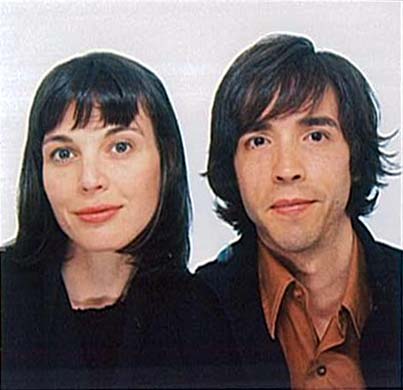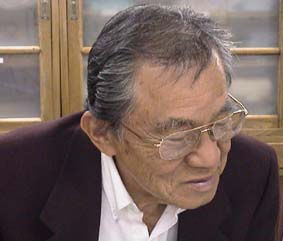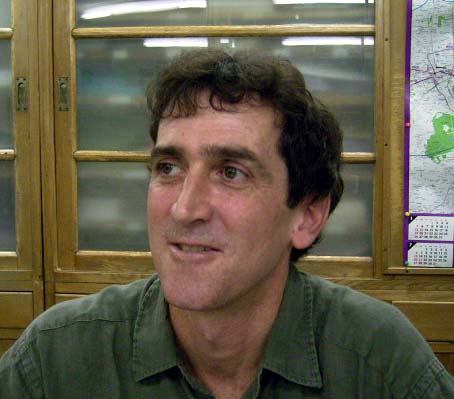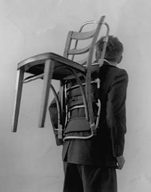Luis Recoder, Filmmaker
February 2 – August 1, 2005
 Luis is a filmmaker who brings “youthful exuberance to materials and ideas which have been around for centuries.” In Japan he immersed himself into the Japanese rock gardens of Kamakura and Kyoto. His research aimed to “observe and develop an approach that would incorporate an interdisciplinary and cross-cultural practice ( the ‘grey areas’) between modern and ancient cultural rites.” During his stay, he completed a work of installation, presented at Youkobo Gallery in Tokyo, entitled “Still Film,” a work of light and shaodw as an “Indirect” expression of his stay in Japan. He was accompanied by his partner, filmmaker Sandra Gibson.Their work was shown at Image Forum Festival. (Kanazawa on 30 June, Yokohama on 30 July)
Luis is a filmmaker who brings “youthful exuberance to materials and ideas which have been around for centuries.” In Japan he immersed himself into the Japanese rock gardens of Kamakura and Kyoto. His research aimed to “observe and develop an approach that would incorporate an interdisciplinary and cross-cultural practice ( the ‘grey areas’) between modern and ancient cultural rites.” During his stay, he completed a work of installation, presented at Youkobo Gallery in Tokyo, entitled “Still Film,” a work of light and shaodw as an “Indirect” expression of his stay in Japan. He was accompanied by his partner, filmmaker Sandra Gibson.Their work was shown at Image Forum Festival. (Kanazawa on 30 June, Yokohama on 30 July)
―
Hiroko Kawai, Choreographer
March 10, 2005 – October 12
 Roko is a Japanese-American dancer and choreographer “working at the intersection of traditional and contemporary forms and developing a conversation between genres, across traditions.” The core of Roko’s residency in Japan consisted of extensive training and exploration of the buyo traditional Japanese dance under the tutelage of buyo master Hanayagi Kazu. Her goal was to “move past the theoretical and intellectual in this exploration–to immerse myself fully in the techniques, customs and attitudes of nihon buyo as it exists in its contemporary context.” In spite of the tendency toward marginalization of the traditional forms of buyo by contemporary dancers, Roko sees an intimate connection between the two genres and was able to discover and foster a dialogue between the two. While in Japan, she gave numerous small performances and presentations, and also participated in her teacher’s gala student recital, presented at the Tokyo National Theater on August 23, 2005.
Roko is a Japanese-American dancer and choreographer “working at the intersection of traditional and contemporary forms and developing a conversation between genres, across traditions.” The core of Roko’s residency in Japan consisted of extensive training and exploration of the buyo traditional Japanese dance under the tutelage of buyo master Hanayagi Kazu. Her goal was to “move past the theoretical and intellectual in this exploration–to immerse myself fully in the techniques, customs and attitudes of nihon buyo as it exists in its contemporary context.” In spite of the tendency toward marginalization of the traditional forms of buyo by contemporary dancers, Roko sees an intimate connection between the two genres and was able to discover and foster a dialogue between the two. While in Japan, she gave numerous small performances and presentations, and also participated in her teacher’s gala student recital, presented at the Tokyo National Theater on August 23, 2005.
―
Jonathan Shirota, Playwright
April 20, 2005 – October 19
 Jonathan, a playwright whose father was an immigrant from Okinawa, grew up as a Japanese-Okinawan- Hawaiian-American. His parents were intent on becoming “good Americans” and therefore ignored anything to do with the “old country.” Jonathan has already written two plays about the Okinawan immigrant experience in Hawaii and is working on his third, to be based on authentic facts and events. In order to gain background material for this third play, he spent his residency in Okinawa researching the source of his heritage. His efforts included interviewing relatives, village leaders and family friends, along with research undertaken in local museums, libraries and newspapers, “to soak in what went on during the war and its aftermaths.”
Jonathan, a playwright whose father was an immigrant from Okinawa, grew up as a Japanese-Okinawan- Hawaiian-American. His parents were intent on becoming “good Americans” and therefore ignored anything to do with the “old country.” Jonathan has already written two plays about the Okinawan immigrant experience in Hawaii and is working on his third, to be based on authentic facts and events. In order to gain background material for this third play, he spent his residency in Okinawa researching the source of his heritage. His efforts included interviewing relatives, village leaders and family friends, along with research undertaken in local museums, libraries and newspapers, “to soak in what went on during the war and its aftermaths.”
―
Lee Easton Durkee, Writer
September 2, 2005 – March 1st. 2006
 Lee is a writer whose fiction has been strongly influenced by Japan, having his first encounter with the culture through Mishima Yukio’s novel, Patriotism. Since then, Lee has found inspiration in the Zen infused writings of Dogen, Muso and Ikkyu, as well as the haiku poet Issa. His own reasons for coming to Japan are, in his own words, “to study the religions and myths of Japan. Shinto is a mystery to me, and I want to learn about the Yamabushi sect of Buddhism. I want to study Japan’s myths and learn how, in Japan, devotion and art interact and how that heritage has affected the modern Japanese writers I admire so much (Murakami Haruki, Ishiguro Kazuo and Abe Kobo). I also want to read the bunraku plays of Chikamatsu Monzaemon and see them performed.”
Lee is a writer whose fiction has been strongly influenced by Japan, having his first encounter with the culture through Mishima Yukio’s novel, Patriotism. Since then, Lee has found inspiration in the Zen infused writings of Dogen, Muso and Ikkyu, as well as the haiku poet Issa. His own reasons for coming to Japan are, in his own words, “to study the religions and myths of Japan. Shinto is a mystery to me, and I want to learn about the Yamabushi sect of Buddhism. I want to study Japan’s myths and learn how, in Japan, devotion and art interact and how that heritage has affected the modern Japanese writers I admire so much (Murakami Haruki, Ishiguro Kazuo and Abe Kobo). I also want to read the bunraku plays of Chikamatsu Monzaemon and see them performed.”
―
Marco Breuer, Visual Artist
December 17, 2005-June 15, 2006
 Marco is a visual artist who derives his inspiration from location, environment and daily experience. His purpose in coming to Japan is to immerse himself in the everyday life of this country and investigate the relationship between a culture and its graphic forms. During the residency, he will divide his time experiencing both the urban and the countryside; exploring the high-tech modern city along with the rural farming villages. Another focus of his residency will be to delve into the variety of book formats in Japan. The book, according to the artist, serves as an ideal vehicle for interdisciplinary dialogue. He envisions the book as a platform for beginning collaborative projects and long-term working relationships with Japanese artists and artisans.
Marco is a visual artist who derives his inspiration from location, environment and daily experience. His purpose in coming to Japan is to immerse himself in the everyday life of this country and investigate the relationship between a culture and its graphic forms. During the residency, he will divide his time experiencing both the urban and the countryside; exploring the high-tech modern city along with the rural farming villages. Another focus of his residency will be to delve into the variety of book formats in Japan. The book, according to the artist, serves as an ideal vehicle for interdisciplinary dialogue. He envisions the book as a platform for beginning collaborative projects and long-term working relationships with Japanese artists and artisans.
―
For profiles and photos of previous artists, please click on the year
|2018|2017|2016|2015|2014|2013|2012|2011|2010|2009|2008|2007
|2006|2005|2004|2003|2002|2001|2000|1999|1978-1998
|Artists’ Profiles TOP| JAPANESE